Introduction
Grasshoppers can be a frustrating pest in any vegetable garden. These voracious insects feed on leaves, stems, and fruits, often causing significant damage that reduces crop yield and quality. If left unchecked, a grasshopper infestation can devastate your carefully cultivated vegetables. This article provides expert-backed, practical strategies to help you get rid of grasshoppers in your vegetable garden effectively and sustainably.
We will explore proven methods ranging from cultural controls and natural predators to organic treatments and preventive measures. Whether you’re a seasoned gardener or a beginner, these actionable tips will help you protect your garden while maintaining an eco-friendly approach.
Understanding Grasshoppers and Their Impact
What Are Grasshoppers?
Grasshoppers are insects belonging to the order Orthoptera, known for their strong hind legs that enable impressive jumps. They thrive in warm, dry environments and are most active during late summer and early fall.
How Do Grasshoppers Damage Vegetable Gardens?
Grasshoppers chew on leaves, stems, flowers, and fruits. They prefer tender, young plants but can consume mature crops too. Damage manifests as ragged holes in foliage or complete defoliation in severe cases, which stunts growth and lowers vegetable production.
Why Control is Necessary
Without control measures, grasshoppers multiply rapidly, especially during dry seasons. Their feeding can spread plant diseases and attract other pests, compounding the threat to your vegetable garden.
Effective Cultural Practices to Reduce Grasshopper Populations
Maintain Healthy Garden Habits
Healthy plants withstand pest damage better. Regular watering, mulching, and fertilizing promote robust growth, helping vegetables recover from occasional grasshopper nibbling.
Remove Weeds and Debris
Grasshoppers lay eggs in soil and plant litter. Removing weeds, grass clippings, and garden debris eliminates their egg-laying sites, reducing future generations.
Crop Rotation and Companion Planting
Rotating crops disrupts grasshopper feeding patterns. Planting companion plants such as coriander, basil, or marigolds can repel grasshoppers due to their strong scents.
Biological and Natural Control Methods
Encourage Natural Predators
Beneficial insects like spiders, ladybugs, and parasitic wasps prey on grasshopper eggs and nymphs. Birds such as sparrows and robins also feed on them. Installing birdhouses and avoiding broad-spectrum insecticides helps maintain these natural allies.
Use Nematodes and Biological Insecticides
Beneficial nematodes (microscopic worms) attack grasshopper eggs in the soil. Additionally, products containing the bacterium Bacillus thuringiensis (Bt) are effective against young grasshoppers without harming other insects.
Homemade Repellents
Spraying a mixture of garlic, hot pepper, and water on plants can deter grasshoppers. This organic approach is safe for edible crops and pets.
Mechanical and Physical Control Techniques
Handpicking
For small gardens, manually removing grasshoppers is effective. Early morning or late evening are best times as grasshoppers are less active.
Barriers and Traps
Floating row covers protect plants by physically blocking grasshoppers. Sticky barriers around plant stems can trap nymphs. Yellow sticky traps attract and capture flying adults.
Tilling the Soil
Tilling disrupts grasshopper egg pods buried in the soil, reducing hatch rates. This should be done in early spring or late fall.
Chemical Control: When and How to Use It Safely
Selective Use of Insecticides
Chemical insecticides should be a last resort. Choose selective, least-toxic options labeled for grasshoppers in vegetable gardens. Always follow label instructions carefully.
Integrated Pest Management (IPM)
Combine chemical treatments with cultural and biological methods for sustainable control. Monitor grasshopper populations regularly to apply insecticides only when necessary.
Safety Precautions
Wear protective gear when applying chemicals and avoid spraying on windy days to prevent drift. Keep children and pets away from treated areas until dry.
Conclusion
Controlling grasshoppers in your vegetable garden requires a multi-faceted approach. By understanding their behavior and life cycle, you can implement cultural, biological, and mechanical controls that reduce their numbers effectively. Use chemical options judiciously and as part of an integrated pest management strategy to protect your garden’s health and biodiversity.
Remember, a healthy garden with diverse plants and natural predators is your best defense against grasshoppers. Start applying these expert tips today to enjoy a vibrant, productive vegetable garden free from grasshopper damage.
